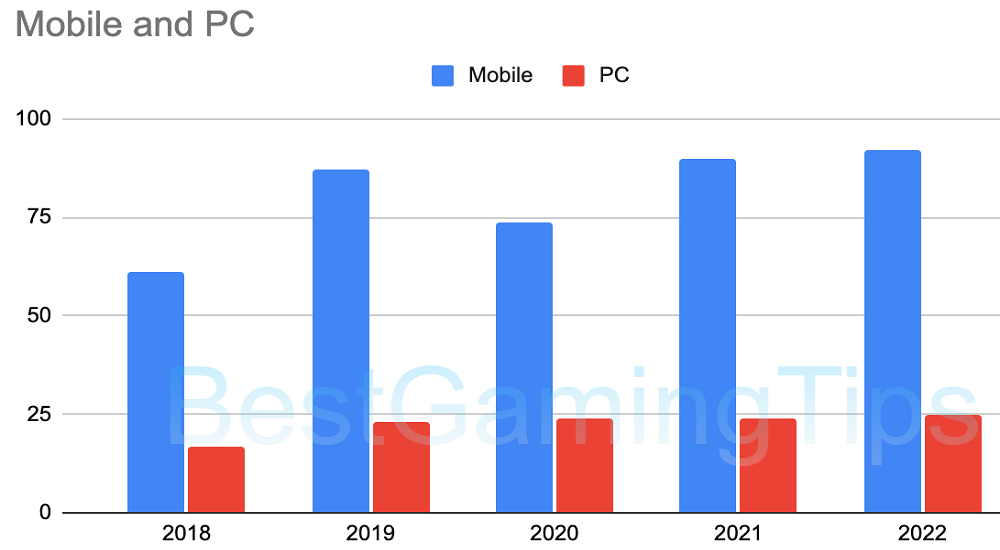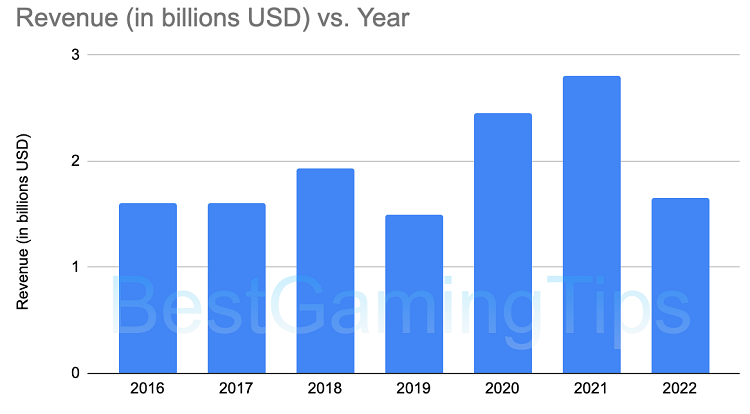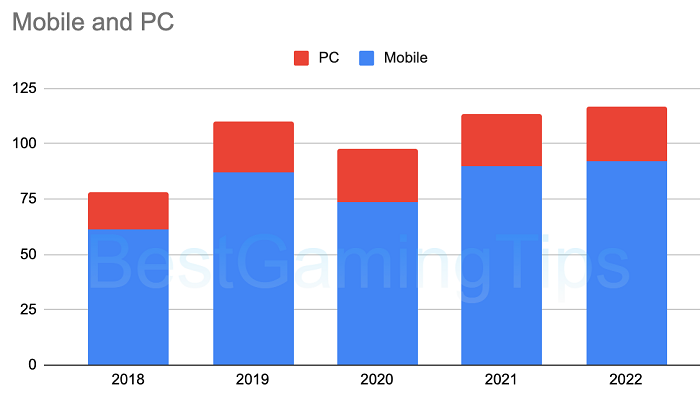In the ever-evolving landscape of the gaming industry, one business model has risen above the rest, revolutionizing the way games are monetized and consumed.
Yes, I’m talking about free-to-play games.
Free-to-play games have become the dominant force, accounting for a staggering 85% of all revenue generated in the digital game industry.
It’s estimated that this percentage will go to 95% by 2025.
This phenomenon has not only transformed the way games are designed and distributed but also how players engage with and spend money on their favorite titles.
Free-to-Play Mobile Games Revenue Increases by 34% from 2018 to 2022
| Year | Mobile (in billions USD) | PC (in billions USD) |
|---|---|---|
| 2018 | 61.3 | 17 |
| 2019 | 87.1 | 23 |
| 2020 | 73.8 | 24 |
| 2021 | 89.6 | 24 |
| 2022 | 92 | 25 |
In 2018, free-to-play games generated $80.3 billion in revenue, out of which $61.3 billion came from mobile, $17 billion from PC, and $2 billion from console. [Source]
In 2019, free-to-play mobile games generated $87.1 billion in revenue worldwide. [Source]
In 2020, they generated $73.8 billion, and in 2021, they reached $89.6 billion. [Source] [Source]
In 2022, mobile games generated $92 billion. [Source]

By comparison, in 2019, F2P PC games generated $23 billion in revenue worldwide; in 2020 and 2021, they reached $24 billion each.
In 2022, free-to-play PC games generated $25 billion. [Source]
Free-to-Play Mobile Games Revenue Trend
Free-to-play mobile games have been experiencing steady growth over the years. In 2019, they generated $87.1 billion, showing a significant increase compared to the previous year.
However, in 2020, there was a slight decrease to $73.8 billion, but this was followed by a strong rebound in 2021, reaching $89.6 billion.
Finally, in 2022, mobile games reached their highest revenue of $92 billion, indicating a continuous upward trend.
Free-to-Play PC Games Revenue Trend
Free-to-play PC games also exhibited growth but at a slower rate than mobile games.
In 2018, they generated $17 billion, which increased to 23 billion in 2019, and $24 billion in both 2020 and 2021.
In 2022, free-to-play PC games generated $25 billion, showing a moderate increase.
What Is the Highest Grossing Free-To-Play Game of All Time?

The highest-grossing free-to-play game of all time is Honor of Kings with a total of $11.6 billion generated between 2016 and May 2023.
The game generated $1.61 billion in revenue in 2016, $1.61 billion in 2017, $1.93 in 2018, $1.5 billion in 2019, $2.45 billion in 2020, $2.8 billion in 2021, $1.65 billion in 2022, and $600M from January to May 2023.
Considering the current trend, the game will likely surpass $1 billion in revenue by the end of the year.
| Year | Revenue (in billions USD) |
|---|---|
| 2016 | 1.61 |
| 2017 | 1.61 |
| 2018 | 1.93 |
| 2019 | 1.5 |
| 2020 | 2.45 |
| 2021 | 2.8 |
| 2022 | 1.65 |
| Jan-May 2023 | 0.6 |
| Total | 11.65 |
[Source: Statista] [Source: SensorTower] [Source:BusinessOfApps] [Source: Variety]
Developed by Tencent Games, Honor of Kings is a multiplayer online battle arena game that was initially released in China in 2015 and expanded to other regions in 2016 as Arena of Valor.
The Rise of Free-to-Play Games
Free-to-play (F2P) games, also known as freemium or free games, allow players to download and play the core content without any upfront cost.
Instead of a traditional one-time purchase, these games offer in-app purchases (IAPs) or microtransactions that players can make within the game to access premium content, features, cosmetics, or virtual items.
This model has proven incredibly successful for developers and publishers, as it opens up the potential player base and encourages ongoing engagement and monetization.
The Appeal to Players
One of the main reasons why free-to-play games have gained such widespread popularity is the accessibility they offer.
Gamers can dive into the game without any financial commitment, allowing them to explore the game’s mechanics and content before deciding whether to invest money in it.
This “try before you buy” approach has been instrumental in attracting a massive player base, including individuals who may have been hesitant to purchase a game upfront.
Moreover, the social nature of many free-to-play games adds to their appeal.
These titles often feature multiplayer modes or in-game communities, where players can interact, team up, or compete with friends and other gamers worldwide.
The social aspect fosters a sense of community and encourages players to spend more time within the game, leading to a higher likelihood of making in-app purchases to enhance their gaming experience.
How Do Free-to-Play Games Make Money?
In-Game Purchases
The success of free-to-play games is closely tied to well-thought-out monetization strategies.
While the core gameplay is free, developers offer various virtual goods or services that players can purchase to enhance their gameplay or aesthetics.
These may include special weapons, outfits, character customizations, power-ups, boosters, and even limited-time events.
The freemium approach allows players to spend as much or as little as they desire, granting them control over their gaming expenses.
Free-to-play games often implement a sense of urgency through time-limited offers or exclusive items, which can drive players to make impulse purchases.
Furthermore, developers regularly release updates, new content, and events to keep the gaming experience fresh and encourage ongoing player engagement and spending.
Ads
Advertising is a common strategy used by game developers and publishers to generate income from their free-to-play titles.
These ads can appear in different formats, such as banners, interstitials, video ads, or rewarded ads.
Players may encounter these ads during loading screens, between levels, or as opt-in opportunities to earn in-game rewards.
Data Monetization
Data monetization in games refers to the process of leveraging player data and user behavior insights to generate revenue for game developers or publishers.
As players interact with games, they generate valuable data, including in-game actions, preferences, time spent playing, purchase history, and more.
Companies can analyze and utilize this data to make informed decisions, optimize game experiences, and, in some cases, create new revenue streams.
Data can be used for targeted in-game advertising.
In some cases, game developers may collaborate with third-party data companies or advertisers to share anonymized and aggregated player data.
These partnerships can create additional revenue streams for the game company while protecting player privacy.
Challenges and Controversies
Despite their resounding success, free-to-play games are not without criticism.
Critics argue that some games employ manipulative tactics, especially when targeting younger or vulnerable audiences, leading to excessive spending on virtual items or loot boxes.
Moreover, there is a concern among some gamers that the free-to-play model might compromise the overall quality of games.
In some cases, developers might prioritize monetization over gameplay balance, leading to a pay-to-win environment where players who spend more money gain significant advantages over others.
The Future of Free-to-Play Games
As technology and gaming trends evolve, free-to-play games’ dominance is likely to persist.
Developers will continue to explore innovative ways to engage players and offer enticing in-game purchases while ensuring fair and transparent monetization practices.
Striking the right balance between player satisfaction and revenue generation will be critical for this business model’s long-term sustainability and success.
References:
-
- GAMING INDUSTRY – FACTS, FIGURES AND
TRENDS, Clairfield.
- GAMING INDUSTRY – FACTS, FIGURES AND
